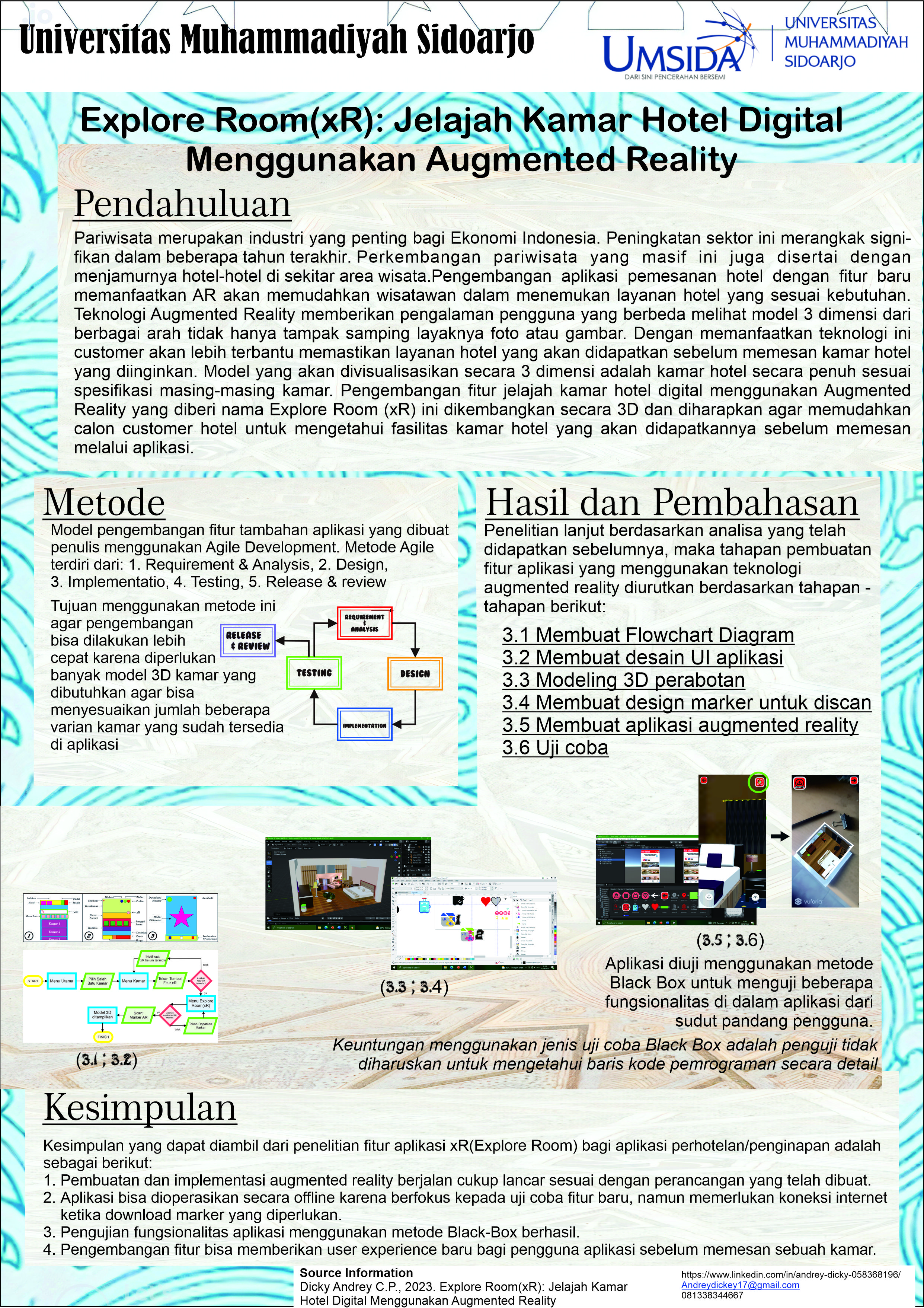Explore Room(xR): Explore Digital Hotel Bedrooms Using Augmented Reality
Explore Room(xR): Jelajah Kamar Hotel Digital Menggunakan Augmented Reality
DOI:
https://doi.org/10.21070/pels.v4i0.1408Keywords:
Augmented Reality, Application's Feature, Agile Development, BedroomAbstract
xR(Explore Room) is an application feature to explore virtual hotel rooms using Augmented Reality. By utilizing Augmented Reality technology, users will be able to ensure the hotel services which will be obtained before booking hotel room. The application feature is developed using the Agile Development method, which is software development method that requires quick adjustments and is able to receive changes repeatedly and oriented towards the quality of the results developed. xR(Explore Room) operates AR technology as the main technology where the feature will display a 3-dimensional model of a hotel room using markers on the phone screens. From use of the Agile method, it is found that the application feature which made requires several improvement for the results to be maximized. The results of application testing suggest adding human resources to produce more 3D room model assets to adjust number of rooms that have been registered in the application.
Downloads
References
B. S. A. Utami and A. Kafabih, “Sektor Pariwisata Indonesia di Tengah Pandemi Covid 19,” Jurnal Dinamika Ekonomi Pembangunan, vol. 4, no. 1, pp. 383–389, 2021, doi: http://dx.doi.org/10.33005/jdep.v4i1.198.
H. K. Nafah and E. Purnaningrum, “Penggunaan Big Data Melalui Analisis Google Trends Untuk Mengetahui Perspektif Pariwisata Indonesia di Mata Dunia,” Seminar Nasional Hasil Riset dan Pengabdian, vol. 3, pp. 430–436, 2021.
J. S. Priyo, B. Mohamad, and R. R. Adetunji, “An Examination of the Effects of Service Quality and Customer Satisfaction on Customer Loyalty in the Hotel Industry,” International Journal of Supply Chain Management , vol. 8, no. 1, pp. 653–663, 2019.
N. A. D. Hutagaol, M. N. K. Nababan, and R. S. Putra, “Aplikasi Pemesanan Kamar Hotel Berbasis Android,” Jurnal Sistem Informasi dan Ilmu Komputer Prima (JUSIKOM PRIMA), vol. 2, no. 2, pp. 45–52, Mar. 2019, doi: 10.34012/jusikom.v2i2.396.
W. Darmawan, I. Kurniawan, and A. F. Rifqiyanto, “Penerapan Location Base Service Untuk Memperkenalkan Hotel dan Wisata Kuliner di Kota Pekalongan Berbasis Augmented Reality,” Jurnal Litbang Kota Pekalongan, vol. 17, pp. 26–35, 2019.
A. F. Ramadhan, A. D. Putra, and A. Surahman, “Aplikasi Pengenalan Perangkat Keras Komputer Berbasis Android Menggunakan Augmented Reality (AR),” Jurnal Teknologi dan Sistem Informasi, vol. 2, no. 2, pp. 24–31, Jul. 2021, doi: 10.33365/jtsi.v2i2.840.
Y. Siriwardhana, P. Porambage, M. Liyanage, and M. Ylianttila, “A Survey on Mobile Augmented Reality With 5G Mobile Edge Computing: Architectures, Applications, and Technical Aspects,” IEEE Communications Surveys & Tutorials, vol. 23, no. 2, pp. 1160–1192, 2021, doi: 10.1109/COMST.2021.3061981.
I. W. W. N. Kusuma, I. G. J. E. Putra, and B. P. W. Nirmala, “GuideAR: Aplikasi Berbasis Augmented Reality dan Global Positioning System untuk Pengenalan Daya Tarik Wisata,” KARMAPATI, vol. 10, no. 1, p. 78, Mar. 2021, doi: 10.23887/karmapati.v10i1.31988.
T. Wibowo and S. Loren , “Perancangan dan Implementasi Media Pembelajaran Aplikasi Desain Grafis dengan Menggunakan Augmented Reality,” CoMBInES - Conference on Management, Business, Innovation, Education and Social Sciences, vol. 1, no. 1, pp. 728–736, 2021.
A. F. Dewi and M. Ikbal, “Perancangan Augmented Reality (AR) Sebagai Media Promosi Objek Wisata Berbasis Android,” Infotek : Jurnal Informatika dan Teknologi, vol. 5, no. 1, pp. 179–186, Jan. 2022, doi: 10.29408/jit.v5i1.4760.
M. P. R. Akbar, Y. Indrianingsih, and A. Ayuningtyas, “Pemanfaatan Media Komunikasi Visual Sebagai Alat Bantu Promosi Obyek Wisata Menggunakan Metode Markerless Augmented Reality (Studi Kasus: Kampung Baran, Desa Salam, Kap. Patuk Gunungkidul),” Seminar Nasional Teknologi Informasi dan Kedirgantaraan, vol. 7, pp. 237–248, Mar. 2022, doi: 10.28989/senatik.v7i0.456.
A. Anwar, C. A. Nalisa, H. Hendrawati, S. Safriadi, and M. Arhami, “Aceh’s Historic Tourist Attractions: An Augmented Reality-Based Prototype of a Virtual Tour Application,” Journal of Informatics and Telecommunication Engineering, vol. 5, no. 2, pp. 502–509, Jan. 2022, doi: 10.31289/jite.v5i2.6460.
A. Wijaya and R. Dijaya, “Brosur Digital Wisata Bukit Gandrung di Desa Medowo Kediri Berbasis Augmented Reality,” JIPI (Jurnal Ilmiah Penelitian dan Pembelajaran Informatika), vol. 6, no. 2, pp. 305–317, Nov. 2021, doi: 10.29100/jipi.v6i2.2003.
A. Nayyar, B. Mahapatra, D. N. Le, and G. Suseendran, “Virtual Reality (VR) & Augmented Reality (AR) technologies for tourism and hospitality industry,” International Journal of Engineering & Technology, vol. 7, no. 2.21, pp. 156–160, Apr. 2018, doi: 10.14419/ijet.v7i2.21.11858.
A. W. Pramestha, “Aplikasi Augmented Reality Location Based Service Rumah Makan di Sekitar Universitas Islam Indonesia Berbasis Android,” Undergraduate Thesis, Universitas Islam Indonesia, Yogyakarta, 2018.
F. Zuli, “Augmented dan Virtual Reality Untuk Media Promosi,” Seminar Nasional Cendekiawan, vol. 4, pp. 273–277, 2018.
A. Karisman, “Aplikasi Media Pembelajaran Augmented Reality Pada Perangkat Keras Komputer Berbasis Android,” JATISI, vol. 6, no. 1, pp. 18–30, Sep. 2019, doi: 10.35957/jatisi.v6i1.166.
A. R. Dayat, Pengaturan Tata Letak Furniture Menggunakan Augmented Reality. Makassar: STMIK Handayani, 2015.




